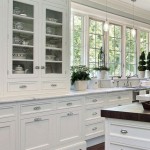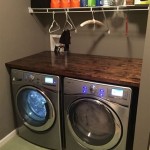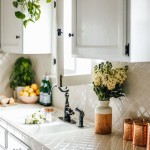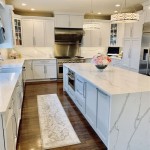What Is The Cheapest Countertop Material?
When embarking on a kitchen or bathroom renovation project, the selection of countertop material is a crucial decision point. Countertops not only define the aesthetic appeal of a space but also contribute significantly to its functionality and durability. While options abound, ranging from luxurious granite and quartz to innovative recycled materials, budget considerations often play a pivotal role in the final choice. Identifying the most cost-effective countertop material requires a careful evaluation of initial costs, installation expenses, maintenance requirements, and long-term durability. This article seeks to provide a comprehensive overview of affordable countertop options, exploring their characteristics, benefits, and potential drawbacks to assist in making an informed decision.
The concept of "cheapest" is multifaceted. It encompasses not just the initial purchase price per square foot but also the associated costs that accumulate over the lifespan of the countertop. Installation, sealing, cleaning, and repair expenses all contribute to the overall cost of ownership. A seemingly inexpensive material that requires frequent maintenance or is prone to damage might ultimately prove more expensive than a slightly pricier option with superior durability. Therefore, a holistic approach to cost analysis is essential.
Laminate Countertops: An Economical Choice
Laminate countertops are frequently recognized as one of the most budget-friendly options available. Constructed by bonding layers of plastic laminate to a particleboard or MDF (Medium-Density Fiberboard) core, laminate offers a wide array of colors, patterns, and textures. The manufacturing process allows for the replication of designs that mimic natural stone, wood, or other high-end materials, providing a cost-effective alternative for achieving a desired aesthetic.
The primary advantage of laminate lies in its affordability. Compared to granite, quartz, or solid surface materials, laminate typically costs significantly less per square foot. Installation is also relatively straightforward, which can reduce labor costs. Many homeowners with basic DIY skills can install laminate countertops themselves, further minimizing expenses.
However, laminate countertops are not without their limitations. They are susceptible to scratches, dents, and heat damage. Direct contact with hot pots or pans can cause blistering or melting, and sharp objects can easily scratch the surface. Once damaged, laminate is difficult to repair, often requiring replacement of the entire section. Furthermore, laminate is not waterproof. Water penetration can cause the particleboard core to swell and warp, leading to irreversible damage. This makes proper sealing and cautious use around sinks and wet areas crucial.
Despite these drawbacks, laminate remains a viable option for budget-conscious homeowners. With proper care and maintenance, laminate countertops can provide a reasonable lifespan. Regular cleaning with mild detergents and the avoidance of abrasive cleaners can help preserve their appearance. Using cutting boards and trivets to protect the surface from scratches and heat is also essential. The wide variety of designs and the low initial cost make laminate a popular choice for rental properties, starter homes, and areas where aesthetics are not the primary concern.
Tile Countertops: Affordability and Design Flexibility
Tile countertops represent another relatively inexpensive option, particularly when using ceramic or porcelain tiles. Tile offers significant design flexibility, allowing for customized patterns, colors, and sizes. The individual tiles are installed onto a cement board underlayment, with grout filling the spaces between them.
The cost of tile countertops varies depending on the type of tile chosen. Ceramic and porcelain tiles are generally more affordable than natural stone tiles like granite or marble. The installation cost can also fluctuate depending on the complexity of the design and the size of the tiles. Smaller tiles typically require more labor to install than larger ones.
A key advantage of tile countertops is their durability. Ceramic and porcelain tiles are resistant to heat, scratches, and stains. They are also waterproof, making them suitable for use in kitchens and bathrooms. Individual tiles can be replaced if damaged, which can be more cost-effective than replacing an entire countertop section.
However, tile countertops have their drawbacks. The grout lines are prone to staining and can be difficult to clean. Regular sealing of the grout is necessary to prevent the absorption of liquids and bacteria. Over time, the grout can crack or crumble, requiring periodic repairs. The uneven surface of tile countertops can also be a concern, particularly when preparing food. Items may wobble, and cleaning can be more challenging than with a smooth, seamless surface.
Nonetheless, tile countertops offer a cost-effective solution for achieving a unique and durable surface. The wide range of tile styles and colors allows for creative design possibilities. Choosing a darker grout color can help minimize the appearance of stains. Regular cleaning and sealing can prolong the lifespan of the grout and maintain the overall appearance of the countertop. For those seeking a budget-friendly option with a customized look, tile countertops can be a suitable choice.
Butcher Block Countertops: Warmth and Affordability Combined
Butcher block countertops, made from strips of hardwood glued together, offer a warm and natural aesthetic. While solid hardwood countertops can be expensive, butcher block provides a more affordable alternative. The cost of butcher block varies depending on the type of wood used, with maple and oak being common and relatively inexpensive options.
Butcher block countertops offer a unique combination of durability and affordability. They are resistant to scratches and dents, and minor imperfections can often be sanded out. The natural wood grain adds character and warmth to a kitchen or bathroom. Butcher block is also a food-safe surface, making it suitable for use as a cutting board.
However, butcher block requires regular maintenance to prevent moisture damage. The wood needs to be sealed with mineral oil or a similar product to protect it from water and stains. Regular oiling helps maintain the wood's moisture content and prevents it from cracking or warping. Butcher block is also susceptible to bacterial growth if not properly cleaned. It is important to use a mild detergent and avoid harsh chemicals that can damage the wood.
The installation of butcher block countertops can be relatively straightforward, particularly for those with woodworking experience. Butcher block can be cut to size and shaped to fit the desired space. Proper sealing is essential after installation to protect the wood from moisture. With proper care and maintenance, butcher block countertops can provide a durable and aesthetically pleasing surface for many years.
The affordability of butcher block, combined with its natural beauty and food-safe properties, makes it a popular choice for homeowners seeking a cost-effective and stylish countertop option. Choosing readily available wood species like maple or oak can help minimize the cost. Regular maintenance is essential to preserve its appearance and prevent damage. For those willing to invest the time and effort in proper care, butcher block countertops can be a worthwhile investment.
Ultimately, the "cheapest" countertop material depends on individual needs, preferences, and budget constraints. Laminate offers the lowest initial cost but requires careful maintenance to prevent damage. Tile provides design flexibility and durability but requires regular grout cleaning and sealing. Butcher block combines affordability with natural beauty but requires regular oiling and careful cleaning to prevent moisture damage and bacterial growth. By carefully considering these factors, homeowners can select the most cost-effective countertop material that meets their specific needs and provides lasting value.

14 Kitchen Countertop Materials Explained

Cutting Edge Designers Favor This Countertop Material For More Than Countertops

14 Kitchen Countertop Materials Explained

14 Kitchen Countertop Materials Explained

Modern Metalwork Stainless Steel In The Kitchen Design Est Living
:max_bytes(150000):strip_icc()/kitchen-countertops-cheat-sheet-1822100-02-9c82905c604141e4bb87f63c049aa686.jpg?strip=all)
35 Options For Kitchen Countertop Materials

Kitchen Countertop Options For Your Remodel Dave Fox

Epoxy Countertops A Beginner S Guide

The Most Expensive Countertop Material To Put In Your Kitchen

Kitchen Countertop Options For Your Remodel Dave Fox
See Also








